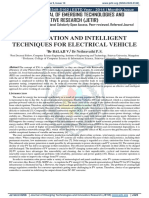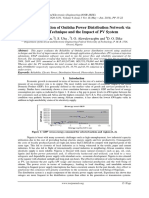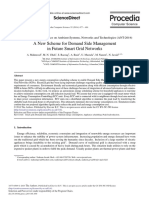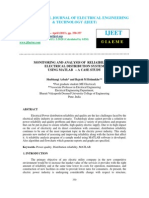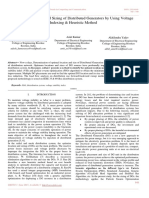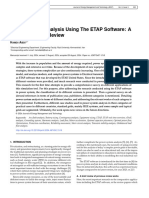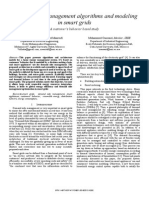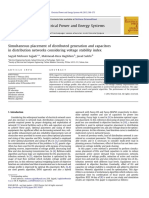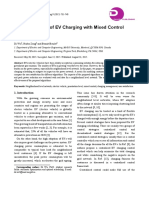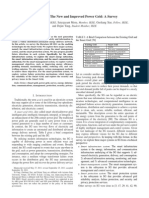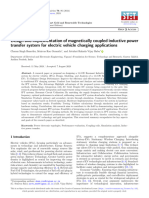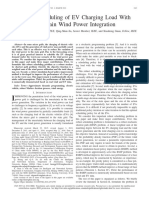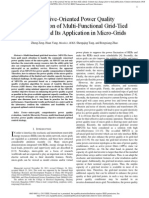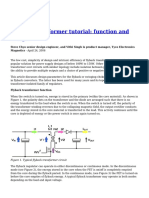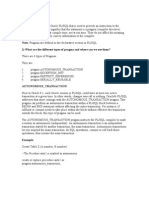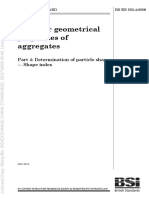Optimal Reliability-Based Placement of Plug-In Electric Vehicles in Smart Distribution Network
Optimal Reliability-Based Placement of Plug-In Electric Vehicles in Smart Distribution Network
Uploaded by
Kitty RaoCopyright:
Available Formats
Optimal Reliability-Based Placement of Plug-In Electric Vehicles in Smart Distribution Network
Optimal Reliability-Based Placement of Plug-In Electric Vehicles in Smart Distribution Network
Uploaded by
Kitty RaoOriginal Description:
Original Title
Copyright
Available Formats
Share this document
Did you find this document useful?
Is this content inappropriate?
Copyright:
Available Formats
Optimal Reliability-Based Placement of Plug-In Electric Vehicles in Smart Distribution Network
Optimal Reliability-Based Placement of Plug-In Electric Vehicles in Smart Distribution Network
Uploaded by
Kitty RaoCopyright:
Available Formats
International Journal of Energy Science (IJES) Volume 4 Issue 2, April 2014
doi: 10.14355/ijes.2014.0402.02
www.ijesci.org
Optimal Reliability-based Placement of
Plug-In Electric Vehicles in Smart
Distribution Network
Mohammadhadi Amini1, Arif I. Sarwat*2
Department of Electrical and Computer Engineering, Florida International University, 10555 W. Flagler St., Miami,
FL 33174, USA
mamin006@fiu.edu; *2asarwat@fiu.edu
Abstract
Distributed renewable resources are one of the major
technological inclinations that play a pivotal role in the
future green power system. In this context, high penetration
of Plug-In Electric Vehicles (PIEVs) may bring many
challenges for the smart grid. PIEVs unscheduled utilization
will cause technical issues for both generation side and
demand side. High penetration of PIEVs may lead to
reliability deterioration of smart distribution network. In this
paper, firstly a PIEV owner behavior model is introduced.
The output of this model is the hourly demand of PIEVs per
day. Secondly, a comprehensive reliability-based objective
function is proposed to allocate these modeled PIEVs in
smart distribution network. Finally, IEEE RBTS bus 2 is used
for implementing allocation algorithm utilizing both genetic
algorithm and particle swarm optimization.
Keywords
Plug-In Electric Vehicle (PIEV); Reliability-based Objective
Function; Smart Distribution Network; Heuristic Optimization
Introduction
Regarding the ever increasing demand for power
generation and limits on current resources only one
suggestion can be practical and economical, that is to
take advantage of distributed renewable resources
(DRRs) and to cut down on reliance on fossil fuels in
order to have a more environmental-friendly power
grid. Hydroelectric, wind power and photovoltaic in
comparison with coal, have shown to have great
potentials since they can be near to the place of energy
demand. Therefore, these sort of energy resources will
require a lot of modern equipment. As standard of life
continues to rise, so have consumer expectations and
demands for power reliability.Considering the great
extent of the grid application of old methods of direct
and continuous supervision by staff is not anymore
feasible and more optimized solutions should be
thought of [1]. In the beginning of the 21st century this
concern led to a great movement smart grid (SG) was
one of its outcomes.
Smart grid will gradually lead to the development and
upgrading of the whole power grid, including electric
power generating, transmission, distribution and
supplying, that creates a more secure, energy-saving,
environmental protection, and economic power
systems [2-3]. Figure 1 demonstrates the role of PIEVs
as distributed resources in the smart grid framework.
Figure 1 shows the schematic view of the industry
drivers of Smart Grid as mentioned in [4]. As shown in
this figure the new face of Smart Grid include (a)
emphasis on environmental protection, including
variable generation (wind, solar, etc.), demand
response, and distributed generation, (b) the drive for
better asset utilization, including operating closer to
the knee of the curve while maintaining reliable
system operation, and (c) the need for enhanced
customer choice[4].
FIG. 1A NOVEL PARADIGMFOR SMART GRID [4]
Another concept which appears in Smart Grid
environment is smart home. Gelling depicts the smart
home with control center and energy management
system as fig 4. In this home, several mentioned
elements of the Smart Grid such as AMI, DG and
electric vehicle are considered [5][6].
43
www.ijesci.org
International Journal of Energy Science (IJES) Volume 4 Issue 2, April 2014
is defined. This function is based on four variables:
electricity price, fuel price, charging rate (fast or slow)
and charging control (controlled or uncontrolled). This
function is shown in (1)[11]:
F j=
(t , p j , y ) FCE j (t , p j ) + FCF j (t , y )
+ FFSPj (t ) + FCUPj ( j )
FIG. 2 FUTURE HOMES, ENABLING SMART GRID
TECHNOLOGIES [5]
As figure 2 shows, Plug-In Electric Vehicles (PIEVs)
are inevitable part of future power system, especially
in smart homes. They can serve as storages like the
flexible loads [7].
If the EV can inject the stored power to the grid, it is
referred to as V2G [8]. Fig.2 depicts a gradual raise in
the amount of EVs and the impact of controlled and
uncontrolled charging curve at the peak load [9-10].
As shown in this figure, uncontrolled charging
deteriorates load curve.
(1)
where "t" represents different times of day, "y" is an
interval in which fuel prices are understood to be fixed
and pj represents time intervals each of which of two
hour duration, as defined by (2):
pj =
[2 j , 2 + 2 j ]
; j {0,1,...,11}
(2)
FCE j , FCFj , FFSPj and FCUPj show the electricity price,
fuel price, fast charging penetration and controlled
charging penetration, respectively.
According to the survey of 30 PHEV owners and curve
fitting on each of the four factors, coefficients
b t , c t
i
and
d t
i
a t
were extracted.
In order to compare different scenarios and
investigating the effect of electricity price on EV
customers' behavior this paper defined a customer
acceptance index (CAI ) [11]. This index is shown in
the following equation:
11
CAI =
FIG.3 FORECASTING THE PEAK INCREASING DUE TO
CONTROLLED AND UNCONTROLLED CHARGING [9]
The rest of this paper is arranged as follows: In the
next section, PIEV's customer behaviormodeling is
introduced. This model is based on PIEV users' survey.
Then, problem formulation is addressed in terms of
defining a reliability-based objective function. Next
section, is devoted to the optimization methodology.
This section will introduce two approaches for optimal
allocation of PIEVs. Case study is discussed after
introducing two optimization methods and the last
section, concludes the paper.
PIEV Owners Behavior Modelling
There is a comprehensive model which introduced in
[11]. For the modeling purpose, an acceptance function
44
2 j +2
j =0 t =2 j
F j (t , p j , y )dt ]
(3)
24
This model is adaptive for customer behavior
prediction. Nevertheless, another model should be
introduced to evaluate the parking lots charging
demand. As the main objective of this paper is
reliability evaluation, only the charging rate is counted
as variable in this model. Figure 5 demonstrates the
charging rate effect on this model output.
TABLE CHARGING RATES IN A PROPORTION OF BATTERY CAPACITY
Charging Mode
Charging Rate
Slow Charging
0.1 BCAP/hour
Quick Charging
0.3 BCAP/hour
Fast Charging
1.0 BCAP/hour
Problem Formulation
In this part, two methods are utilized to allocate the
PIEVs in the smart distribution network. Firstly, a
reliability-based objective function is introduced for
International Journal of Energy Science (IJES) Volume 4 Issue 2, April 2014
the optimization purpose. The proposed objective
function can be shaped based on various purposes.
The input of proposed objective function is the output
of probabilistic PIEV model which is discussed in
section II. Furthermore, the characteristic of the smart
distribution network which is used for the simulation
purposes is another input of optimization process.
Objective function of PIEVs placement in a feeder is
subject to improve power distribution system
reliability satisfying some constraints. Two influential
reliability indices are used in order to evaluate the
distribution network's reliability; The Customer
Average Interruption Duration Index (CAIDI) which is
commonly used by power utilities in order to consider
the average outage duration that is expectable for
customer to experience, and energy not supplied (ENS)
are considered [12].
The proposed objective function (OF) illustrated in the
following equation, indicates composite reliability
index through weighted aggregation of these two
indices [13]:
OF = (CAIDI
CAIDI
ENS
) + ( ENS
)
CAIDI T
ENS T
(4)
Where OF is a composite reliability index and
coefficient x > 0 indicates the weight for
corresponding reliability index and subscript T
indicates the target value of each index. These
coefficients are considered to be the same value 0.5,
and the objective value of CAIDI and ENS are
considered 1.5 hours (based on IEEE Standard 13661998 this index's value is about 1.36 for the North
American utilities) and 47, respectively. In the
proposed optimization framework, technical issues of
power distribution network such as power
consumption of PIEVs and voltage constraints are
considered.
Optimization Using Particle Swarm
Optimization and Genetic Algorithm
In order to optimize the proposed objective function
there are various population-based heuristic methods
include genetic algorithms, evolutionary computation,
and particle swarm optimization (PSO). Prior research
using the genetic-algorithm (GA) and simulatedannealing (SA) techniques has provided effective
optimal designs for various apparatuses and systems
[14][20]. In this paper the optimization is obtained
utilizing both GA and PSO so that the comparison
between results from these two optimization methods
leads to more accuracy in placement process.
www.ijesci.org
Because of the discrete nature of allocation process, it
has numbers of local minimums. To optimize this type
of objective function, heuristic algorithms may be
effective. In this paper genetic algorithm (GA) is used
to minimize the proposed objective function
containing two high-flying reliability indices [13]. In
this paper fitness function of genetic algorithm and
objective function considered to be the same. The
chromosomes include binary numbers which
determine the number of buses that PIEV groups
should be connected to the smart distribution network
at them. Candidate load points in the test system are
just residential and commercial buses and the number
of candidate load points does not exceed 24-1, each
chromosome for PIEV bus number is five bits so the
population size is five. Other GA parameters, cross
over fraction, mutation probability and population
size set 0.65, 0.18 and 50 respectively [15]. The
reliability-based objective function optimization is
shown in Figure 4.
Particle swarm optimization (PSO) algorithm is
introduced by Kennedy and Elberhart [16-18],
supposed to be a optimization method based on the
social behavior of flocks of birds. Optimization starts
by generating random positions for particles. In order
to avoid defined articles from leaving search space at
the first iteration, these randomly-generated positions
should be zero or a small value. Based on (5) and (6)
standard version of PSO algorithm starts by generating
random positions for the particles, within an
initialization region. Velocities are usually initialized
within that region, but they can also be initialized to
zero or to small random values to prevent particles
from leaving the search space during the first iterations.
During the main loop of the algorithm, the velocities
and positions of the particles are iteratively updated
until a stopping criterion is met. The update rules are
shown in (5) and (6).
V i k +1 =
wV i k + C 1rand 1 + ( Pbest ik X ik
+ C 2 rand 2 (Gbest ik X ik
+1
X ik=
X ik + Vi k +1
(5)
(6)
whereXi = [Xi1, Xi2 ,...., Xid] and Vi = [Vi1, Vi2,...., Vid] in are
the position and velocity of the ith particle. Let Pbesti =
[Xi1pbest, Xi2pbest,.,Xidpbest] and Gbest = [X1gbest, X2gbest,.....,
Xdgbest] be the best position of particle i and its neighbors
best position so far respectively. The key attractive
feature of PSO is its simplicity as it involves only two
models (5) and (6).
45
www.ijesci.org
International Journal of Energy Science (IJES) Volume 4 Issue 2, April 2014
=
max
(max min ) iter
itermax
(7)
PIEV Owners Behavior
Modeling Considering
Specific Charging Rates and
Various Number of Vehicles
Initial population
random generation
[10]. In order to evaluate the proposed algorithm, it is
tested on distribution system for RBTS [19][21]. This
radial test system consists of four feeders with four
types of customers,
residential, commercial,
government/institutions and small user that
commercial and residential ones were considered as
candidates for EVs' parking placement. The test
system is shown in Figure 6. As a result, first and
second feeders are connected as maneuver points with
normally open switches. In addition, third and fourth
feeders are also connected in the same way. The
candidate buses do not include the exclusive industrial
customers.
OF calcuation
Printing
Results
Yes
Termination
Criteria
No
Selection
Cross over
FIG. 6 DISTRIBUTION SYSTEM FOR RBTS BUS 2 [19]
Mutation
FIG. 4 OBJECTIVE FUNCTION OPTIMIZATION UTILIZINTG
GENETIC ALGORITHM
Simulation Results
Four scenarios are defined to
effectiveness of the proposed method.
evaluate
the
Scenario 1
In this scenario the slow charging method was
considered. 1000 PIEVs considered to be allocated in
five buses.
Scenario 2
FIG. 5 COMPARING FAST AND SLOW CHARGING METHOD[10]
In this scenario the fast charging method was
considered. 1000 PIEVs considered to be allocated in
five buses. The goal of defining this scenario is to
evaluate the effect of charging rate on the proposed
objective function and optimal placement of PIEVs.
Case Study
Scenario 3
Firstly, as it is mentioned in figure 5 the effect of
charging rate is evaluated based on the PIEV model
In this scenario the slow charging method was
considered. 1500 PIEVs considered to be allocated in
46
International Journal of Energy Science (IJES) Volume 4 Issue 2, April 2014
five buses.
Scenario 4
In this scenario the fast charging method was
considered. 1500 PIEVs considered to be allocated in
five buses. This scenario is defined to achieve a
sensitivity analysis on charging rate effect on the value
of proposed objective function.
Table II shows the results of optimization with GA
and PSO. As the results shown, when the charging
rate starts increasing, the OF value will reduce. For
instance, the value of OF for fast charging is less than
that of Slow and quick charging, considering the same
number of PIEVs. Furthermore, a comparison between
results of first and thirds scenario illustrates that when
the number of PIEVs increased, OF value increased
and this means the reliability will deteriorate by
increasing PIEV number. Therefore, although the
optimal allocation of PIEVs considering reliability
indices improves reliability deterioration, high
penetration of PIEVs reduce the level of reliability and
in order to maintain an acceptable level of reliability,
other smart equipments should be utilized at same
time.
Figure 7 represents the value of proposed objective
function using GA and PSO for introduced scenarios.
www.ijesci.org
As results of this figure shows, particle swarm
optimization is preferable for the reliability-based
allocation of PIEVs and utilizing this optimization
method leads to better reliability improvement.
Conclusion and Future Work
In this paper, a novel reliability-based placement of
PIEVs utilizing two well-known heuristic optimization
methods, GA and PSO, is introduced. The proposed
method prevents future distribution network, called
smart
distribution
network,
from
reliability
deterioration after high penetration of PIEVs. Key
feature of this approach is to consider two influential
reliability indices simultaneously by defining a
specific objective function. The case study results
conclude that it is not feasible to connect PIEVs to
industrial load points.
For the validation purpose, the proposed method has
been implemented on distribution system for RBTS
bus 2. The results of simulations show the high
correlation of PIEV optimal location with charging
method as well as total number of PIEVs (PIEV
penetration). This paper analyzed the technical aspects
of PIEV placement, including reliability features of
distribution network. Future studied can concentrate
on economical optimization of PIEVs' high penetration.
TABLE SIMULATION RESULTS
Scenario number
Charging Method
Total EVs
OF value (GA)
OF value (PSO)
WITHOUT EV
1
2
3
4
5
6
SLOW
FAST
SLOW
FAST
QUICK
QUICK
1000
1000
1500
1500
1000
1500
1.05512
1.09134
1.06742
1.11397
1.09981
1.08136
1.10072
1.05512
1.08134
1.0731
1.11237
1.0878
1.08093
1.09900
PIEVs' optimum
location
1, 8, 10-11, 18
2, 12, 16, 18-19
1,6-7,17-18
2, 10, 12, 15, 19
1, 7, 16, 18-19
1, 6, 15, 17, 19
FIG.7 OPTIMAL VALUE OF PROPOSED OBJECTIVE FUNCTION USING GA AND PSO
47
www.ijesci.org
International Journal of Energy Science (IJES) Volume 4 Issue 2, April 2014
REFERENCES
L. Wang and C. Singh, " Reliability-constrained optimum
Sargolzaei, Arman, Kang K. Yen, and M.N. Abdelghani.
Time-Delay Switch Attack on Load Frequency Control
in
Smart
Grid. Advances
in
Communication
Technology, Vol.5 (2013), 55-64.
Du Xin-Wei, Ye Qiang, 2005,"Review of Smart Grid and its
Development Prospect in Sichuan, " IEEE power &
energy magazine.
Amin S.M., Bruce F.W., 2005, Toward a smart grid, IEEE
power & energy magazine, vol. 34, No. 5, pp. 34-41.
F. Rahimi and A. Ipakchi, Demand response as a market
resource
under the smart grid
paradigm,
IEEE
Transactions on Smart Grid, vol. 1, no. 1, pp. 82-88, 2010.
Clark W. Gellings, The Smart Grid: Enabling Energy
Efficiency and Demand Response, Published by The
Fairmont Press, Inc, 2009.
Farhadi, M.; Mohammed, O., "Realtime Operation and
Harmonic Analysis of Isolated and Non-Isolated Hybrid
DC Microgrid," Industry Applications, IEEE Transactions
on , vol.PP, no.99,pp.1,1. doi: 10.1109/TIA.2014.2298556.
Zahra Darabi, Mehdi Ferdowsi, "Aggregated Impact of Plugin Hybrid Electric Vehicles on Electricity Demand
Profile", IEEE Trans. On sustainable energy, vol. 2, no. 4,
Oct. 2011.
W. Kempton, and J. Tomic, Vehicle to grid Implementation:
from stabilizing the grid to supporting large-scale
renewable energy, Journal of Power Sources, vol. 144,
no.1, pp.280-294, Jun. 2005.
P. Mohseni, and R.G. Stevie, Electric Vehicles: Holy Grail or
Fools Gold, IEEE General Meeting, Calgary, Alberta,
Canada, 2009.
M.H. Amini, and M. Parsa Moghaddam. "Probabilistic
modelling of electric vehicles' parking lots charging
demand." Electrical Engineering (ICEE), 2013 21st Iranian
Conference on. IEEE, 2013.
M.H. Amini, B. Nabi, M. Parsa Moghaddam and S.A.
Mortazavi, " Evaluating the Effect of Demand Response
Programs and Fuel Cost on PHEV Owners Behavior, A
Mathematical Approach", Second Iranian Conference on
Smart Grid, 2012.
R.
E.
Brown,
Electric
PowerDistribution
NewYork:Marcel Dekker, 2002.
48
Reliability.
placement of reclosers and distributed generators in
distribution networks using an ant colony system
algorithm ", IEEE Transaction on Systems, Man and
CyberneticsPart C: Applications and Reviews, vol. 38,
No. 6, November 2008.
Moghadasi, A.H.; Heydari, H.; Farhadi, M., "Pareto
Optimality for the Design of SMES Solenoid Coils
Verified
by
Magnetic
Field
Analysis,"Applied
Superconductivity, IEEE Transactions on , vol.21, no.1,
pp.13,20, Feb. 2011.
Williams, E. A., and Crossley, W. A., Empirically-Derived
Population Size and Mutation Rate Guidelines for a
Genetic Algorithm with Uniform Crossover, Soft
Computing in Engineering Design and Manufacturing, P.
K. Chawdhry, R. Roy and R. K. Pant (editors), SpringerVerlag, 1998, pp. 163-172.
J. Kennedy and R.C. Eberhart, Particle Swarm Optimization,
Proceedings of the IEEE International Conference on
Neural Networks, Vol.4, pp. 1942-1948, 1995
Kennedy, J. and Eberhart, R., Swarm Intelligence, Academic
Press, 1st edition, San Diego, CA, 2001.
Eberhart, R. C. and Kennedy, J. A new optimizer using
particle
swarm theory.
Proceedings
of the
Sixth
International Symposium on Micromachine and Human
Science, Nagoya, Japan. pp. 39-43, 1995
R.N.Allan, R.Billinton, I.Sjarief, L.Goel and K.S.So,
reliability test system for educational purposes- basic
distribution system data and results, IEEE Transactions
on Power Systems, vo1.6, No. 2, May 1991.
Heydari, H.; Moghadasi, A.H., "Optimization Scheme in
Combinatorial UPQC and SFCL Using Normalized
Simulated
Annealing,"
Power
Delivery,
IEEE
Transactions on , vol.26, no.3, pp.1489,1498, July 2011.
M.H. Amini, B. Nabi and M. -R. Haghifam, Load
management
using
multi-agent
systems
in
smart
distribution network, IEEE PES General Meeting,
Vancouver, BC, Canada, 2013.
MohammadhadiAminiwas
born
in
Shahreza. He received the B.S. and M.Sc.
degree in electrical engineering from Sharif
University
of
Technology
and
TarbiatModares University in 2011 and
2013, respectively. He is currently working
International Journal of Energy Science (IJES) Volume 4 Issue 2, April 2014
toward the Ph.D. in electrical engineering at Florida
International University. He has published more than 25
papers in Smart Grid Implementation field. His research
interests include Smart Grid reliability assessment, real-time
load estimation, smart grid mathematical modeling,plug-in
electric vehicles, power system optimization and power
system state estimation.
Arif I. Sarwatreceived his M.S. degree in
electrical and computer engineering from
University of Florida, Gainesville. In 2010
Dr. Sarwat received his Ph.D. degree in
electrical engineering from the University
of South Florida. He worked in the
industry(SIEMENS)
for nine years
executing many critical projects. Before joining Florida
www.ijesci.org
International University as Assistant Professor, he was
Assistant Professor of Electrical Engineering at the
University at Buffalo, the State University of New York
(SUNY) and the Deputy Director of the Power Center for
Utility Explorations. He is co-developer of the DOE funded
Gateway to Power (G2P) Project along with FPL/NextEra
company. His significant work in energy storage, microgrid
and DSM is demonstrated by Sustainable Electric Energy
Delivery Systems in Florida. He is also co-principle
investigator in the study of reliability & predictability of
high penetration renewable resources power plants (DOE)
funded Sunshine State Solar Grid Initiative (SUNGRIN). His
research areas are Smart Grids, High Penetration Renewable
Systems, Power System Reliability, Large Scale Distributed
Generation Integration, Large Scale Data Analysis,
Distributed Power Systems, and Demand Side Management.
49
You might also like
- A Comprehensive Power Loss, Efficiency, Reliability and Cost Calculation of A 1 MW/500 KWH Battery Based Energy Storage System For Frequency Regulation ApplicationDocument12 pagesA Comprehensive Power Loss, Efficiency, Reliability and Cost Calculation of A 1 MW/500 KWH Battery Based Energy Storage System For Frequency Regulation ApplicationGerson ChavarriaNo ratings yet
- Innovation Landscape brief: Electric-vehicle smart chargingFrom EverandInnovation Landscape brief: Electric-vehicle smart chargingNo ratings yet
- Ijeet: International Journal of Electrical Engineering & Technology (Ijeet)Document11 pagesIjeet: International Journal of Electrical Engineering & Technology (Ijeet)IAEME PublicationNo ratings yet
- Icpsop Rjordan v3Document5 pagesIcpsop Rjordan v3rjordan217No ratings yet
- 3rd Paper PDFDocument8 pages3rd Paper PDFMuhammad Asghar KhanNo ratings yet
- Electrical & Electronic SystemsDocument6 pagesElectrical & Electronic SystemsSaadat BahramiNo ratings yet
- Energies: Vehicle Electrification: New Challenges and Opportunities For Smart GridsDocument20 pagesEnergies: Vehicle Electrification: New Challenges and Opportunities For Smart GridsMahabub HaiderNo ratings yet
- Short Term Load ForcastingDocument21 pagesShort Term Load ForcastingAkah PreciousNo ratings yet
- Conference Paper (Italy)Document7 pagesConference Paper (Italy)AbdUllah EETNo ratings yet
- 42AW Conference PaperDocument7 pages42AW Conference Paperrudreshsj86No ratings yet
- V2G Strategy For Improvement of Distribution Network Reliability Considering Time Space Network of EvsDocument19 pagesV2G Strategy For Improvement of Distribution Network Reliability Considering Time Space Network of Evsbabu tech guruNo ratings yet
- An Optimal Hybrid Management of Electric Vehicle Fleet Charging and Load Scheduling in Active Electric Distribution SystemDocument12 pagesAn Optimal Hybrid Management of Electric Vehicle Fleet Charging and Load Scheduling in Active Electric Distribution SystemMD SHAMIM HASANNo ratings yet
- Optimization and Intelligent Techniques For Electrical VehicleDocument15 pagesOptimization and Intelligent Techniques For Electrical VehicleViswanathanBalajiNo ratings yet
- Distributed Optimal Energy Management in MicrogridsDocument10 pagesDistributed Optimal Energy Management in MicrogridsFlorin NastasaNo ratings yet
- The Smart GridDocument26 pagesThe Smart GridchukwukaNo ratings yet
- Generation Expansion Planning Considering Renewable EnergiesDocument11 pagesGeneration Expansion Planning Considering Renewable EnergiesAJER JOURNALNo ratings yet
- Combined Operations of Renewable Energy Systems and Responsive Demand in A Smart GridDocument9 pagesCombined Operations of Renewable Energy Systems and Responsive Demand in A Smart GridDARPANNo ratings yet
- Grid-Connected EV Charging With Renewable Energy Integration in Parking LotsDocument64 pagesGrid-Connected EV Charging With Renewable Energy Integration in Parking LotsGHANSHYAM MEENANo ratings yet
- An Intelligent Load Management System With Renewable Energy Integration For Smart HomesDocument14 pagesAn Intelligent Load Management System With Renewable Energy Integration For Smart HomesektNo ratings yet
- A Multiobjective Particle Swarm Optimization For Sizing and Placement of Dgs From DG Owner'S and Distribution Company'S ViewpointsDocument10 pagesA Multiobjective Particle Swarm Optimization For Sizing and Placement of Dgs From DG Owner'S and Distribution Company'S ViewpointseaclickerNo ratings yet
- b109 PDFDocument8 pagesb109 PDFWoldemariam WorkuNo ratings yet
- Article 2 VEDocument13 pagesArticle 2 VErobin barracouNo ratings yet
- Predictive Modeling of Electric Vehicle Loads Through Driving Behavior Analysis (15)Document8 pagesPredictive Modeling of Electric Vehicle Loads Through Driving Behavior Analysis (15)ftrxarpitNo ratings yet
- +J Procs 2014 05 450 PDFDocument8 pages+J Procs 2014 05 450 PDFhadiNo ratings yet
- Adaptive Multiresolution Energy Consumption Prediction For Electric VehiclesDocument11 pagesAdaptive Multiresolution Energy Consumption Prediction For Electric VehiclesMuhammed AlhanoutiNo ratings yet
- The Concept of Ev S Intelligent Integrated Station and Its Energy FlowDocument29 pagesThe Concept of Ev S Intelligent Integrated Station and Its Energy FlowHorváth PéterNo ratings yet
- Energies: Reliability Enhancement in Power Networks Under Uncertainty From Distributed Energy ResourcesDocument24 pagesEnergies: Reliability Enhancement in Power Networks Under Uncertainty From Distributed Energy ResourcesAli HadiNo ratings yet
- Monitoring and Analysis of Reliaibility of Electrical Distribution SystemDocument8 pagesMonitoring and Analysis of Reliaibility of Electrical Distribution SystemIAEME PublicationNo ratings yet
- TSP Energy 27821Document15 pagesTSP Energy 27821Paran JothiNo ratings yet
- 173 1498633335 - 28-06-2017 PDFDocument5 pages173 1498633335 - 28-06-2017 PDFEditor IJRITCCNo ratings yet
- Stability Cogitated Electric Vehicle Charging Infrastructure PlanningDocument9 pagesStability Cogitated Electric Vehicle Charging Infrastructure PlanningTareq AzizNo ratings yet
- JEMT - Volume 8 - Issue 3 - Pages 250-294 - ReviewDocument45 pagesJEMT - Volume 8 - Issue 3 - Pages 250-294 - ReviewhichamNo ratings yet
- Demand-Side ManagementDocument6 pagesDemand-Side Managementluca2527No ratings yet
- Sajjad I 2013Document10 pagesSajjad I 2013Yuli Asmi RahmanNo ratings yet
- Aprajita Tripathi, Shilpi Sisodia - 2014 - Comparative Study of Reliability Assessment Techniques For Composite Power System Planning & ApplicationsDocument6 pagesAprajita Tripathi, Shilpi Sisodia - 2014 - Comparative Study of Reliability Assessment Techniques For Composite Power System Planning & ApplicationsCraciunAnaMariaNo ratings yet
- Processes: Inverter E Power Estimation Using Solar RadiationDocument19 pagesProcesses: Inverter E Power Estimation Using Solar RadiationSujeet KumarNo ratings yet
- Impact Analysis of EV Charging With Mixed Control StrategyDocument10 pagesImpact Analysis of EV Charging With Mixed Control StrategyAndreea StefanaNo ratings yet
- Ev Paper 3Document9 pagesEv Paper 3JAGANNATH PATRANo ratings yet
- Load Profiling and Its Application To Demand Response - A ReviewDocument13 pagesLoad Profiling and Its Application To Demand Response - A Reviewconstance59No ratings yet
- Energies 11 03494 v2Document26 pagesEnergies 11 03494 v2Syarifah AdrianaNo ratings yet
- Topic 6 Services Final Report With Alt TextDocument34 pagesTopic 6 Services Final Report With Alt TextriddheeNo ratings yet
- Grid Connected PV System ThesisDocument5 pagesGrid Connected PV System Thesisafktlrreerdihj100% (2)
- Probabilistic Optimal Reactive Power Planning in Distribution Systems With Renewable Resources in Grid-Connected and Islanded ModesDocument10 pagesProbabilistic Optimal Reactive Power Planning in Distribution Systems With Renewable Resources in Grid-Connected and Islanded ModesMahshid JanbozorgiNo ratings yet
- Energies 05 04665 PDFDocument18 pagesEnergies 05 04665 PDFeng_ahmed4444No ratings yet
- Smart Grid Survey 2011 Research PaperDocument38 pagesSmart Grid Survey 2011 Research Paperdheerajdb99No ratings yet
- Battery Energy Storage Systems in MicrogridsDocument18 pagesBattery Energy Storage Systems in MicrogridsPhúc LạiNo ratings yet
- 2011 Event DrivenDemandResponseDocument7 pages2011 Event DrivenDemandResponseJAMESJANUSGENIUS5678No ratings yet
- Energies 10 00523 PDFDocument22 pagesEnergies 10 00523 PDFChetan KotwalNo ratings yet
- Design and Implementation of Magnetically CoupledDocument16 pagesDesign and Implementation of Magnetically CoupledgjylkaNo ratings yet
- 11 Economic Dispatch of Micro-Grid Based On IPSODocument6 pages11 Economic Dispatch of Micro-Grid Based On IPSOMuhammad RidhwanNo ratings yet
- Introduction Notes On OADGDocument4 pagesIntroduction Notes On OADGGowtami NamburuNo ratings yet
- Microgrid IntelligentDocument12 pagesMicrogrid IntelligentAymen1981No ratings yet
- Design of Bidirectional Battery Charger For ElectrDocument13 pagesDesign of Bidirectional Battery Charger For ElectrMaryam MemonNo ratings yet
- 2 Realization NCDocument6 pages2 Realization NClogapriyamurugan2003No ratings yet
- 2019 Energies 12Document21 pages2019 Energies 12ain khairinaNo ratings yet
- A New Algorithm Is Employed For The Efficient Allocation of Distributed Generation ResourcesDocument9 pagesA New Algorithm Is Employed For The Efficient Allocation of Distributed Generation ResourcesInternational Journal of Applied Power EngineeringNo ratings yet
- Robust Scheduling of EV Charging Load With Uncertain Wind Power IntegrationDocument12 pagesRobust Scheduling of EV Charging Load With Uncertain Wind Power IntegrationjoesimonwalterNo ratings yet
- Objective-Oriented Power Quality Compensation of Multi-Functional Grid-Tied Inverters and Its Application in Micro-GridsDocument11 pagesObjective-Oriented Power Quality Compensation of Multi-Functional Grid-Tied Inverters and Its Application in Micro-Gridssk.karimeeeNo ratings yet
- Microsoft Excel-Based Tool Kit for Planning Hybrid Energy Systems: A User GuideFrom EverandMicrosoft Excel-Based Tool Kit for Planning Hybrid Energy Systems: A User GuideNo ratings yet
- 2 Bad FuelDocument16 pages2 Bad FuelMyintzin HtoonNo ratings yet
- Gorkha Eco Panel PDFDocument61 pagesGorkha Eco Panel PDFSaurav ShresthaNo ratings yet
- SCRIPTSDocument13 pagesSCRIPTSannepaka mahendarNo ratings yet
- DM1 ADocument34 pagesDM1 AgonzalohghNo ratings yet
- Rdso Master List (Aug 2018) PDFDocument63 pagesRdso Master List (Aug 2018) PDFAnindita ChatterjeeNo ratings yet
- High Performance 2022Document64 pagesHigh Performance 2022Richard AcevedoNo ratings yet
- Experimental Study On Hybrid Fiber Reinforced Concrete - A ReviewDocument12 pagesExperimental Study On Hybrid Fiber Reinforced Concrete - A ReviewJames AugustineNo ratings yet
- Capacity Building For The Public SectorDocument46 pagesCapacity Building For The Public SectoramazingpongaNo ratings yet
- Air Handling Units DDM E 201701Document20 pagesAir Handling Units DDM E 201701HendrickMazVargasNo ratings yet
- Experimental Investigation of Using Papercrete and Recycled Aggregate As A Coarse AggregateDocument10 pagesExperimental Investigation of Using Papercrete and Recycled Aggregate As A Coarse AggregateInternational Journal of Application or Innovation in Engineering & ManagementNo ratings yet
- MSDS-Pigment Orange 62Document2 pagesMSDS-Pigment Orange 62CanchindoNo ratings yet
- Operating System AdministrationDocument6 pagesOperating System AdministrationRahulsrivasNo ratings yet
- Ameron Industrial CatalogDocument355 pagesAmeron Industrial Catalogaaltuve10No ratings yet
- Cement Composition and Special Cements - Part 2Document14 pagesCement Composition and Special Cements - Part 2Kaushal KumarNo ratings yet
- StructuralAnalysesOfJack upsInElevatedConditionDocument12 pagesStructuralAnalysesOfJack upsInElevatedConditionNavalArchitectureNo ratings yet
- Classification of CottonDocument12 pagesClassification of CottonKingson_786No ratings yet
- Din 2403 (2007)Document15 pagesDin 2403 (2007)Generosa Ferreira100% (1)
- Luxury Living Personified: 3-Storey Bungalow at Bukit JelutongDocument18 pagesLuxury Living Personified: 3-Storey Bungalow at Bukit JelutongMohd KhairulazharNo ratings yet
- Aluminum Removal From Drinking WaterDocument5 pagesAluminum Removal From Drinking Watermohamad azipNo ratings yet
- Flyback Transformer Tutorial Function and DesignDocument5 pagesFlyback Transformer Tutorial Function and DesignDany NewbyNo ratings yet
- Revised: 2012 EditionDocument10 pagesRevised: 2012 EditionSanny Marissé Ventura LunaNo ratings yet
- YowDocument3 pagesYowbecksgirl723No ratings yet
- A Machine Learning Based WSN System For Autism Activity RecognitionDocument10 pagesA Machine Learning Based WSN System For Autism Activity Recognitionnabeel hasanNo ratings yet
- CH-52 (Doors)Document99 pagesCH-52 (Doors)Zayar Lwin100% (1)
- Solved Examples - AerodynamicsDocument7 pagesSolved Examples - Aerodynamicsloay alyaldinNo ratings yet
- Bluetooth+SpeakersDocument11 pagesBluetooth+Speakersbanny5No ratings yet
- Transmitter SML 10Document2 pagesTransmitter SML 10alamsyah_syamNo ratings yet
- 1) What Is Pragma?Document3 pages1) What Is Pragma?sagar_vishwaNo ratings yet
- New 2013 Fujitsu ProductsDocument5 pagesNew 2013 Fujitsu ProductsChris HaukNo ratings yet
- En 933-4 Flaskiness ShapeDocument14 pagesEn 933-4 Flaskiness ShapeHugoStiglic100% (1)












